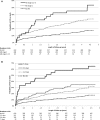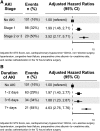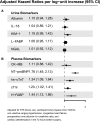Relationship of Kidney Injury Biomarkers with Long-Term Cardiovascular Outcomes after Cardiac Surgery
- PMID: 28808078
- PMCID: PMC5698070
- DOI: 10.1681/ASN.2017010055
Relationship of Kidney Injury Biomarkers with Long-Term Cardiovascular Outcomes after Cardiac Surgery
Abstract
Clinical AKI, measured by serum creatinine elevation, is associated with long-term risks of adverse cardiovascular (CV) events and mortality in patients after cardiac surgery. To evaluate the relative contributions of urine kidney injury biomarkers and plasma cardiac injury biomarkers in adverse events, we conducted a multicenter prospective cohort study of 968 adults undergoing cardiac surgery. On postoperative days 1-3, we measured five urine biomarkers of kidney injury (IL-18, NGAL, KIM-1, L-FABP, and albumin) and five plasma biomarkers of cardiac injury (NT-proBNP, H-FABP, hs-cTnT, cTnI, and CK-MB). The primary outcome was a composite of long-term CV events or death, which was assessed via national health care databases. During a median 3.8 years of follow-up, 219 (22.6%) patients experienced the primary outcome (136 CV events and 83 additional deaths). Compared with patients without postsurgical AKI, patients who experienced AKI Network stage 2 or 3 had an adjusted hazard ratio for the primary composite outcome of 3.52 (95% confidence interval, 2.17 to 5.71). However, none of the five urinary kidney injury biomarkers were significantly associated with the primary outcome. In contrast, four out of five postoperative cardiac injury biomarkers (NT-proBNP, H-FABP, hs-cTnT, and cTnI) strongly associated with the primary outcome. Mediation analyses demonstrated that cardiac biomarkers explained 49% (95% confidence interval, 1% to 97%) of the association between AKI and the primary outcome. These results suggest that clinical AKI at the time of cardiac surgery is indicative of concurrent CV stress rather than an independent renal pathway for long-term adverse CV outcomes.
Keywords: acute renal failure; cardiovascular disease; mortality risk.
Copyright © 2017 by the American Society of Nephrology.
Figures






References
MeSH terms
Substances
Grants and funding
LinkOut - more resources
Full Text Sources
Other Literature Sources
Research Materials
Miscellaneous

